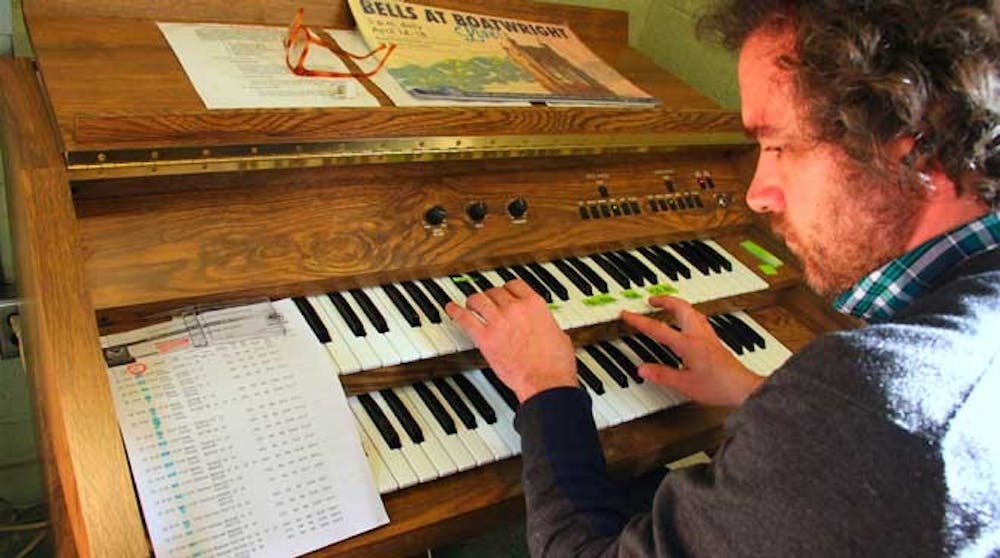Professor Martin Bonadeo sits before the carillon, a two-tier keyboard in the upper reaches of Boatwright tower, scanning a sheet of wind direction data gathered by the Richmond airport. He is transforming the data into sound, by playing the wind readings as musical notes, and practicing for a week-long musical exploration that will begin Monday.
Bonadeo will be animating the campus breezes through music from April 14 to 18 from the Boatwright bell tower, and will play at Byrd Park on Easter. He is a visiting professor in the Latin America and Iberian Studies department, and teaches Latin American and Argentine contemporary art at Universidad Catolica Argentina, a Richmond partner university in Buenos Aires, Argentina.
To "play the wind," Bonadeo developed an algorithm so that each direction of the airport's wind sensor corresponds to a different note in a pentatonic scale. There are eight notes because their are eight wind directions. Twenty-four hours of data will be translated into four minutes of playing time.
Each hour of wind data will be composed into 10 seconds of music. Bonadeo has spent hours listening to wind chimes, familiarizing himself with how they react to certain winds.
The vision for Bonadeo's wind representation came while he was a visiting scholar at University of California, Los Angeles in 2004. He was taking a class called "soundscapes," and was influenced significantly by John Cage's work at UCLA in the 1960s. Bonadeo said the initial idea for this kind of project came from hearing a diverse set of students at UCLA speaking different languages on their phones.
"I noticed that everyone who was on a cell phone was speaking in different languages," Bonadeo said. "And I thought the place was beautiful, as it is here, and I felt that people were not connected completely to that place."
Bonadeo said he hoped people would hear the odd bell patterns during his performances, and pause long enough to appreciate the campus or Byrd Park more deeply.
Aurora Hermida-Ruiz, the LAIS department chairwoman, said she imagined people would hear the bells and wonder what was happening, and that moment of confusion would connect people to the present moment.
"More than the actual piece of music is the effect that it will have on people," Hermida-Ruiz said. "I imagine people might think that the carillon is broken or something has gone wrong. Whatever happens, they will stop and not focus on the phone."
Bonadeo is also the keynote speaker of this year's LAIS student symposium, which will take place April 16. The event features research presentations from all LAIS student majors, and usually begins with an address from a guest speaker, Hermida Ruiz said.
"Normally we invite a professor from elsewhere," Hermida-Ruiz said. "This year was the time for Spain to be the focus, because last year it was Cuba. Since we had Martin Bonadeo here we decided that it was much better to use him."
At the Boatwright bell tower, Bonadeo will play a standard keyboard carillon, but at Byrd Park he will test his feet on a pedal-operated carillon.
Enjoy what you're reading?
Signup for our newsletter
He said it was not difficult to play these wind readings on the standard keyboard, but he felt nervous about the pedal carillon.
"It's very simple to play this kind of piece," Bonadeo said. "It's not like playing a song, it's very intuitive, they way I play it. It's like playing with it."
Contact staff writer Clay Helms at clay.helms@richmond.edu
Support independent student media
You can make a tax-deductible donation by clicking the button below, which takes you to our secure PayPal account. The page is set up to receive contributions in whatever amount you designate. We look forward to using the money we raise to further our mission of providing honest and accurate information to students, faculty, staff, alumni and others in the general public.
Donate Now



